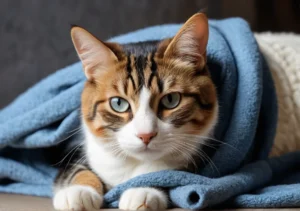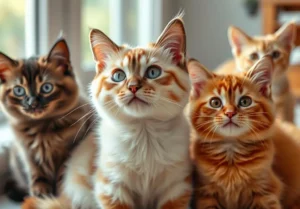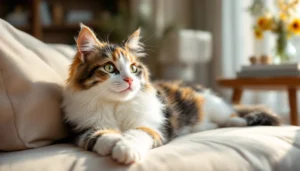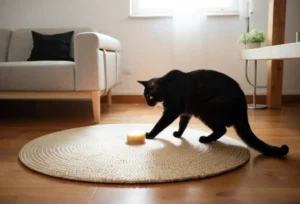Cats are known for their mysterious and often quirky behavior. One particularly curious habit that many cat owners have observed is their tendency to massage babies. But why do cats do this? Let’s explore the fascinating reasons behind this adorable behavior.
Cats have a natural instinct to knead or massage soft surfaces, which can be traced back to their kittenhood. This behavior is often a way for cats to show affection, mark their territory, or simply feel comfortable and secure. When it comes to babies, cats may massage them for a variety of reasons, from trying to establish a bond to providing a sense of comfort and security.
Instinctual Behavior
Cats massaging babies may seem like a strange sight, but it actually stems from their instinctual behavior. Cats are known to knead or massage soft surfaces, such as blankets or pillows, as a way to mark their territory with scent glands located in their paw pads. When they extend this behavior to babies, it’s a way for them to claim the baby as part of their territory and show their ownership and protection over the little one. This instinctual behavior is deeply rooted in a cat’s natural instincts to care for and protect their young, even if that young one happens to be a human baby.
Affection and Bonding
Cats also use massage as a means of showing affection and bonding with babies. Just like how a mother cat would groom her kittens to show love and care, cats may massage babies as a way to express their affection towards them. This gentle kneading motion can be soothing for both the cat and the baby, creating a bond between them through the shared experience. Additionally, the rhythmic motion of the massage can help calm both the cat and the baby, fostering a sense of security and comfort in their relationship. This bonding activity can strengthen the connection between the cat and the baby, creating a unique and heartwarming bond that transcends species.
- Cats may massage babies as a way to show protection and ownership over them.
- The kneading motion can be a soothing and bonding experience for both the cat and the baby.
- Massaging babies allows cats to express their affection and care towards them, similar to grooming behavior with their own young.
Remember, if you notice your cat massaging your baby, it’s important to supervise the interaction to ensure both the cat and the baby are safe and comfortable. Enjoy witnessing this special bond between your feline friend and your little one – it’s a heartwarming display of love and care.
Comfort and Security
Cats are known for their nurturing instincts, and when they massage babies, they may be providing them with a sense of comfort and security. The gentle kneading action mimics the feeling of being nursed by their mother, creating a calming and soothing effect on the baby. This physical contact can help establish a bond between the cat and the baby, fostering a sense of trust and safety in their presence. The rhythmic motion of the massage may also help the baby relax and feel at ease, making them more receptive to the cat’s presence. Overall, the act of massaging babies may be a way for cats to show care and affection, fostering a positive relationship between the two.
Social Hierarchy
In a cat’s world, social hierarchy plays a significant role in their behavior towards babies. Cats are territorial animals that establish a pecking order within their social groups, and this hierarchy influences how they interact with other creatures, including babies. When a cat massages a baby, it may be asserting its dominance in the household hierarchy, viewing the baby as a member of their group that requires nurturing and protection. By engaging in this behavior, the cat is establishing a sense of authority and control over the baby, reinforcing their position within the family dynamic. This gentle act of massage can also be a way for the cat to demonstrate their caregiving instincts and mark their territory within the home environment.
Additional Insight:
– Cats may also massage babies as a way to mark them with their scent, further reinforcing their bond and ownership over the baby. This scent marking behavior helps the cat establish a sense of familiarity and belonging, creating a harmonious environment for both the cat and the baby.
Mimicking Behavior
Cats may massage babies as a way of mimicking the behavior they see from caregivers. Cats are highly observant animals and may notice that humans sometimes massage babies to soothe them or show affection. By imitating this gentle touch, cats may be trying to bond with the baby and provide comfort, just like they see their human family members do.
- Another unique insight: Some experts suggest that cats may also be trying to mark the baby with their scent through gentle kneading, as a way of claiming the baby as part of their territory.
Stress Relief
When it comes to stress relief, cats may massage babies to not only soothe themselves but also to help calm the baby. Cats are known for kneading as a way to self-soothe and alleviate anxiety. By gently kneading on the soft skin of a baby, cats may find a sense of comfort and relaxation. This calming behavior can also have a positive effect on the baby, helping them feel soothed and secure in the presence of the purring feline.
For more information on how cats display stress relief through massage behavior, check out this resource: Cat Stress Relief Techniques.
Remember, while cats massaging babies can be a cute and endearing sight, it’s essential to supervise these interactions to ensure the safety and well-being of both the cat and the baby. By understanding the reasons behind this behavior, you can appreciate the unique bond that cats and babies can share.
Sensory Stimulation
Cats massaging babies can provide valuable sensory stimulation that aids in the baby’s development. The gentle pressure and kneading motion of a cat’s paws on a baby’s skin can help improve blood flow and circulation, which can be soothing and calming for the baby. This sensory input can also help babies become more aware of their own bodies, promoting body awareness and motor development.
Additionally, the soft purring sound that often accompanies a cat’s massage can provide auditory stimulation for the baby, helping to calm them and create a sense of security. This sensory experience of touch and sound can contribute to the baby’s overall sensory development, making them more attuned to their environment and able to respond to stimuli in a healthy way.
Interesting Facts About Cats and Babies
Have you ever noticed that cats seem to have a special bond with babies? It turns out, there are some fun and fascinating trivia about cats and babies that explain their behavior towards each other. One interesting fact is that cats are naturally drawn to the warmth and scent of babies, which can make them want to snuggle up and provide comfort through gentle massages.
Another intriguing fact is that cats have a nurturing instinct that can be activated when they interact with babies. This instinct can lead cats to mimic grooming behaviors, such as licking and kneading, which can be soothing for babies and create a sense of security. Overall, the unique relationship between cats and babies showcases the nurturing and caring nature of these animals, making them wonderful companions for young children.
- Cats often massage babies using their paws, which is a behavior rooted in their instinct to groom and care for others.
- Some researchers believe that cats and babies share a mutual attraction due to their similarities in size and movement patterns.
- Cats can help teach babies about empathy and social cues through their gentle interactions and body language.
- It’s important to always supervise interactions between cats and babies to ensure the safety of both parties.
Remember, if you have any concerns about your cat’s behavior towards your baby, it’s always best to consult with a veterinarian or animal behaviorist for guidance.
Alex, a passionate animal lover, has experience in training and understanding animal behavior. As a proud pet parent to two dogs and three cats, he founded AnimalReport.net to share insights from animal experts and expand his knowledge of the animal kingdom.




